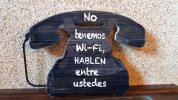IMO, now is a wonderful time to travel with internet and a smart phone and ATMs. Isn’t it really about how and when we use these tools?
Excuse me just taking a snapshot of your excellent post, it is indeed a wonderful time to travel.
But then it has been for many years - with or without cell phones. My mother made a world trip way back in the late 50s/ early 60s, everything was a lot slower (and the photos were inevitably presented as slides!) to. But the slowness of the journeys was a positive in itself.
My own travels started in the late 1980s, just as air travel became dramatically cheaper. Cheaper, faster, but not necessarily better.
You've done 10 more years of travel than I but nonetheless I relate very much with a great many of the points you raise about these tools - because tools they are. You successfully highlight most of technologies positives.
But technology has its dark side too. I hear stories time and again of people who have horrific employers demanding that they be contactable at all hours of the day and night, checking their keystrokes, the number (and length!) of the bathroom breaks they make, questioning the length of time they spent stopped at a cafe or petrol station whilst on a road trip - the list goes on.
In the past we had the ability to get away from overbearing, demanding bosses/ friends/family members when we traveled - because we simply were not contactable. No longer. (If you're strong enough to turn off your phone, you're strong enough to tell them to 'back off' in the first place).
This forum has a policy setting out guidelines about posting reports of missing pilgrims - and quite rightly. Occasionally those people are not missing at all - they have deliberately dropped off the grid. And it's up to all of us to respect that. If the technology didn't exist, the policy wouldn't need to either.
Previously a thief could only steal the cash that I was carrying. (The travellers cheques were absolutely useless to them). Although technically it is more secure, electronic banking, credit cards etc have all increased the possible number of ways that people can steal from us, and how much they can potentially take.
Information technology: Cyber security is a major issue nowadays, a hacker can divulge the private information of thousands of people with a simple keystroke.
Other disadvantages of the technological age is the reduced social skills that have occasionally eventuated from excessive technology usage, addiction to technology, difficulty retaining information and so forth. Whilst technology helped us during coronavirus, it hindered us too. Some young people are struggling to this day with the issues they developed during the enforced isolation which technology allowed.
And on camino it's very easy to retreat to our phones/kindle etc at the end of the day, whether it's to contact loved ones, listen to our music, or simply browse the forum. In the past I had to physically write a journal, and if I wanted contact with somebody, I had to talk to those around me. Playing cards or a board game was always a great icebreaker, regardless of language.
Technology has also taken away a little of the magic of travel. I was traveling for nine years from the late 80s through the 90s, and I knew little about where I was going other than from some documentary or book. Frequently the decision on where to go next was made by listening to a fellow traveler over a shared meal in a hostel, or discussed during a shared bus or train journey.
Nowadays it's hard to avoid the plethora of information that is available to you on every destination possible. Previously you had to seek the information, now you have to avoid overload.
I don't miss for an instant sleeping in train stations or under a bridge, but then neither do I regret the experience. And the 'stresses' of finding a bed for the night in a strange town have not been reduced (as many posts here on the forum will attest). In fact if anything I believe people worry about it more now than they did previously.
I could go on, but this post is already far too long.
It was a glorious time before the internet and the smartphone!
Yes, parts of it were. For me personally it was certainly simpler. I loved dropping off the grid for weeks, even months at a time, going wherever my last night's conversation (and funds!) permitted. Dropping the odd postcard or occasional letter to valued people as proof of life.
I'm far more accountable now.
But without the internet and the smartphone
we wouldn't be connected. And that, I would miss.
Not all was good, not all was bad.
Exactly!






























